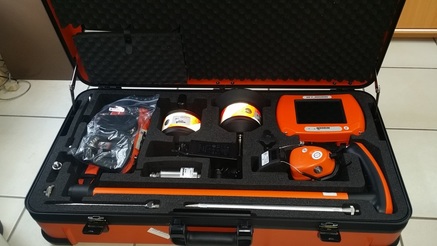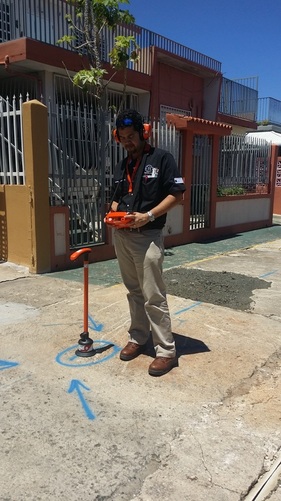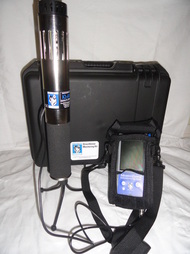|
We are pleased to announce that we now provide GPR services to our clients.
GPR (Ground Penetrating Radar) is the general term applied to techniques which employ radio waves, typically in the 1 to 1000 MHz frequency range, to map structures and features buried in the ground (or in man-made structures). Ground Penetrating Radar works by emitting a pulse into the ground and recording the echoes that result from subsurface objects. Essentially, with our Noggin unit, we'll be able to interpret the data to identify underground pipes, cables, voids, geo-physical issues in the sub-surface, frankly we could possibly interpret forensic investigations. We have two units, Noggin for large outdoor surveys for sub-surface work & Conquest for concrete assessment, Noggin, has various uses for sub-surface detection, some of these areas that we can use the Noggin are, Sub-surface Engineering, Concrete & Pavement, Geo-technical Environment, Archaeology & Cemeteries, Forensics & Military, Mining & quarrying as well as Agriculture & Forestry. At, HTG we mostly will be using the unit for Sub-Surface Engineering along with concrete & pavement however the wide usage of this system can allow for greater applications. With the Conquest we can easily identify rebars, pipes, and conduits within concrete up to 24" thick (concrete build up will ultimately determine depth of penetration) This system can be used to identify where not to drill or dig within concrete, it has many other uses. When cutting and coring for renovation and repair, avoiding reinforcing bars, post-tension cables and embedded conduits is a priority. GPR can sense both metallic and non-metallic features making it a versatile imaging tool. Construction records for many buildings are not readily available and construction often differs from design resulting in GPR being the only way to confirm what is there. Give us a Call to discuss how this service can help you today.
5 Comments
Water Leak Detection ServicesPlumbing leaks can be elusive and destructive. Water leaks can cost hundreds of dollars every day. HTG Engineers use the most technologically advanced non-invasive methods to accurately locate hidden water leaks. Through our time-tested processes of "Leak Detection Without Destruction", you save resources, time, and money by incurring minimal disruption to your property. This can be used on asphalt, walls concrete, tiles, etc. We are happy to be bringing this level of Service to you our Clients. Contact us at [email protected] for more information  We are proud to begin offering Thermal Imaging to our list of services. We have recently procured an infrared professional camera that meets the European Union's standards for infrared inspection services. We have also purchased an Indoor Air Quality meter to add the analysis of a buildings air quality. With this we are now able to datalog and walk through offices, rooms, spaces, etc. and check for improper air quality within these areas. For July we are running a huge discount on these services, contact us to find out more. What is Power Factor?
Power factor is defined as the percentage ratio between the true power, measured in kilowatts (kW), and apparent power, measured in kilovolt amperes (kVA). The apparent power is the total requirement that a facility places upon the electric utility to deliver voltage and current, without regard for whether or not it does actual work. Electric utilities typically charge customers a higher rate when power factor falls below a certain level — often 90%. You calculate power factor as follows: True power (kW) ÷ apparent power (kVA) = power factor Here’s an example of a good power factor value at a facility: 50kW ÷ 52kVA = 0.96 (a good power factor of 96%) Now, here’s an example of a poor power factor value at a facility: 50kW ÷ 63kVA = 0.79 (a poor power factor of 79%) taken from EC&M - http://ecmweb.com/weeblylink_new_window Most people will get an electricity bill at the end of the month and complain about the high energy costs, but how many people actually know what is contributing to the energy bill?
How many know why the bills are high one month and lower/higher the next? How many know if their electrical power distribution systems are efficiently passing power into the house equipment? Do you want a correctly sized generator without making your electrician oversize it by rule of thumb? For those with Solar PV systems installed, do you know if you are getting the maximum from your high capital investment? Many people want to conserve whatever they can. We at HTG Engineering have the tools to answer all your questions. Before we do, post some responses to the questions posed above. This website was created after a 3-hour workshop with David Bain and his team. Check out http://www.lab.com.jm/index.html for further information on how you too can create your own website in minutes. We did it!!! The website is up. Information will be added in the days to come. It is also mobile-compatible.
|
AuthorHugh T. Gordon is a registered professional engineer in Jamaica. Archives
January 2019
Categories
All
|





 RSS Feed
RSS Feed
